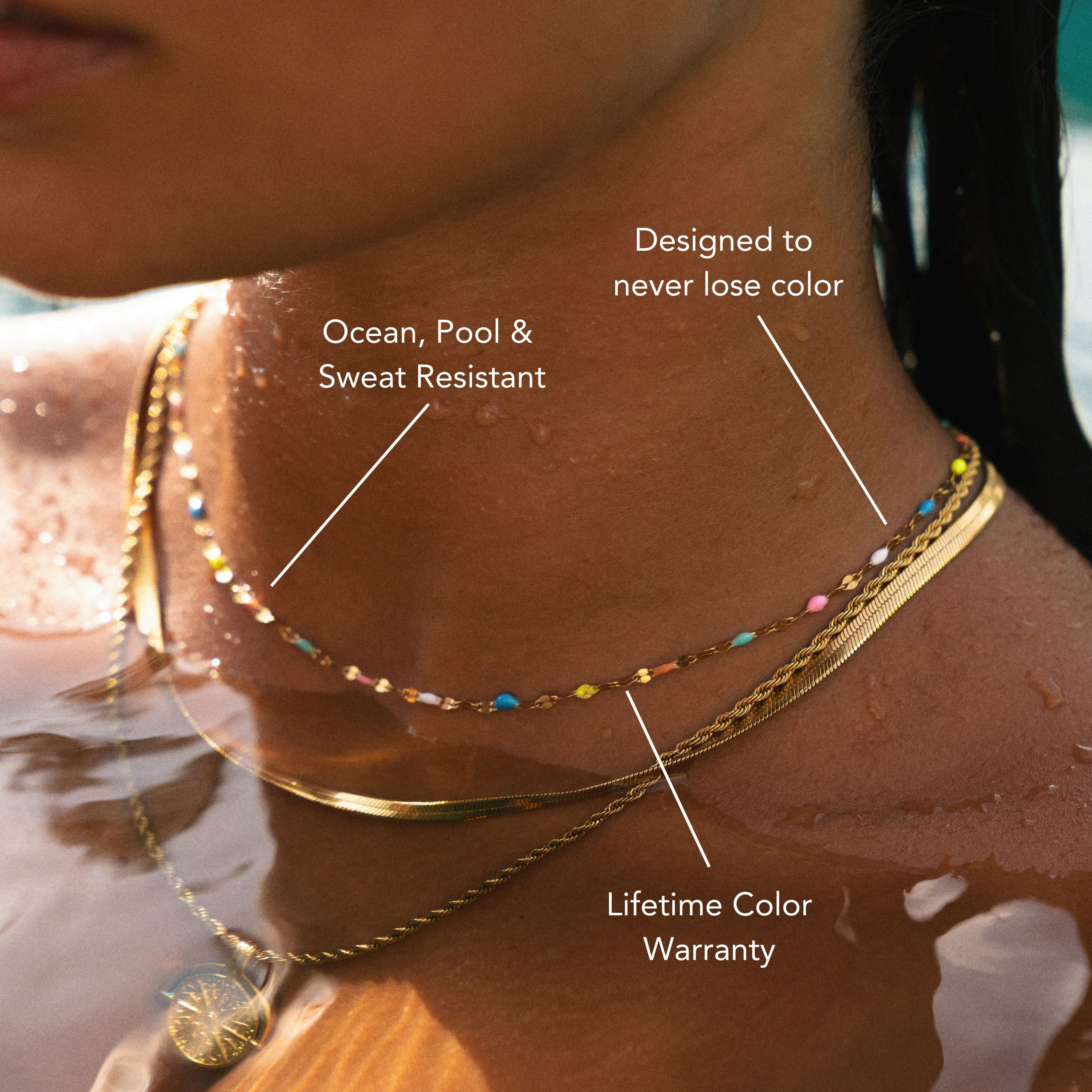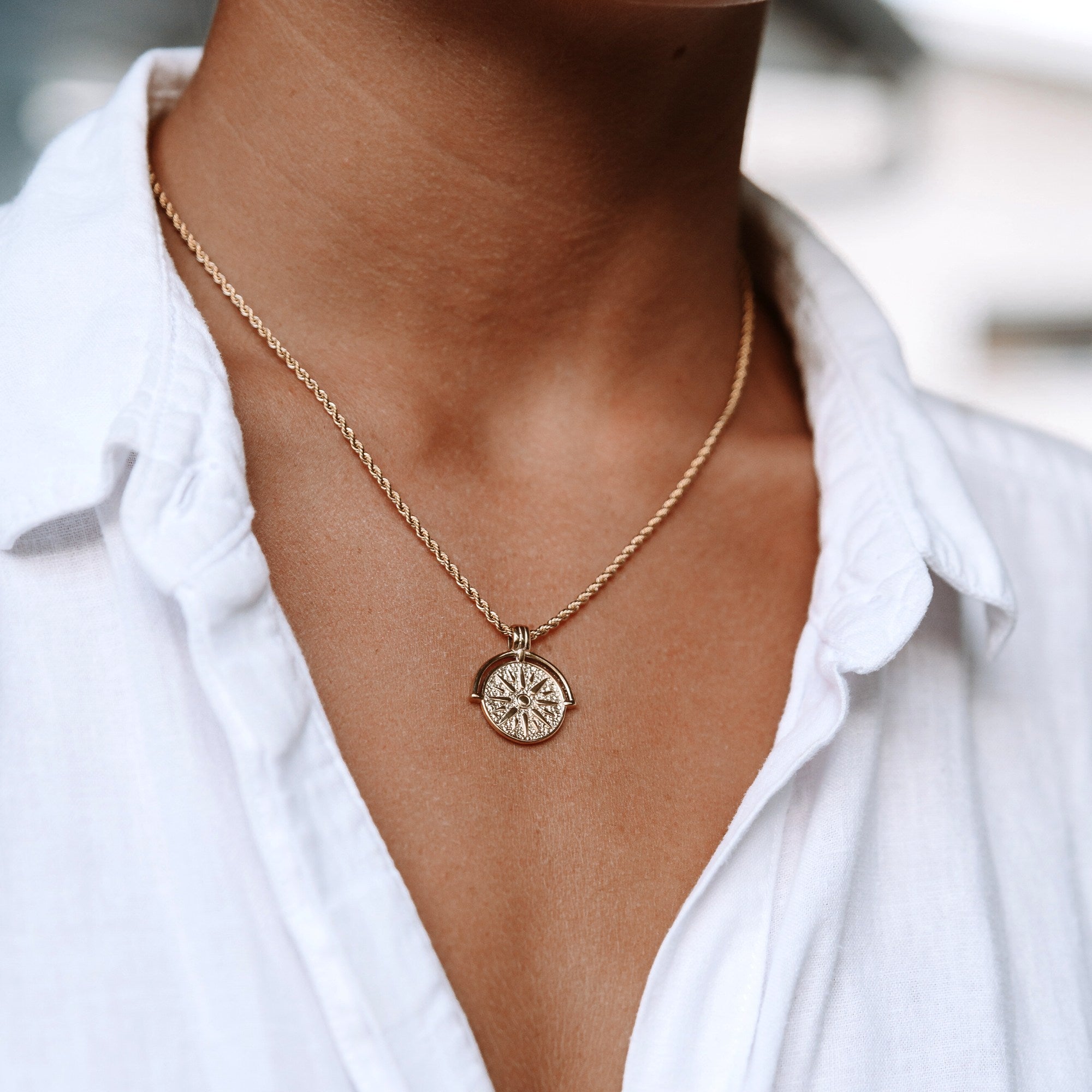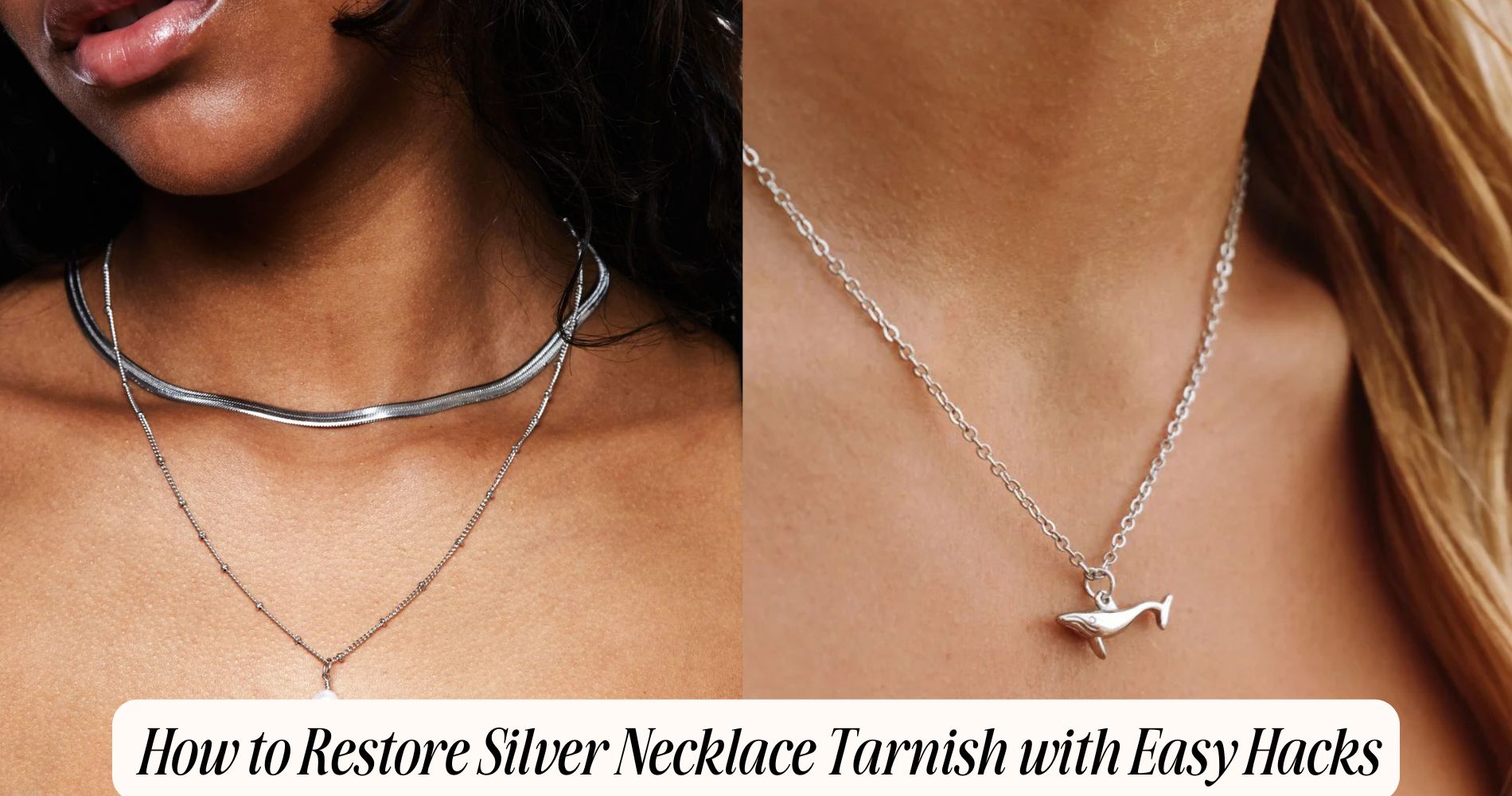
What Does 925 Mean on Jewelry?
Wondering what does 925 mean on jewelry? The "925" stamp signifies that the piece is made of 92.5% pure silver, meeting the sterling silver standard. The remaining 7.5% is typically made up of copper or other metals, enhancing durability while keeping the jewelry's shine intact. This specific alloy is essential because pure silver alone is too soft for everyday wear. The "925" mark not only confirms the quality of the jewelry but also adds to its investment value. To learn more about 925 jewelry, explore our waterproof jewelry collection.
Understanding Silver Purity
When you explore the world of silver jewelry, you'll often come across the term "925," which signifies a specific level of purity. This number indicates that the piece contains 92.5% pure silver, with the remaining 7.5% typically made up of other metals, often copper.
These silver alloys enhance the durability and strength of the jewelry, making it less prone to scratching and tarnishing compared to pure silver.
Understanding this purity level is essential for jewelry valuation. A piece marked with "925" is generally more valuable than those with lower silver content, as it represents a higher quality standard.
When you're shopping for silver jewelry, look for this hallmark to guarantee you're investing in a quality item.
Additionally, knowing about silver alloys can help you appreciate the craftsmanship behind each piece. The combination of metals not only affects the appearance but also the longevity of the jewelry.
The History of 925 Silver
To truly appreciate 925 silver, you need to understand its rich history.
Originating as sterling silver, this alloy combines 92.5% silver with other metals to enhance its durability and usability.
Over the centuries, its composition has set the standard for quality, making it a significant element in jewelry and craftsmanship.
Origin of Sterling Silver
Have you ever wondered about the origins of sterling silver and what makes it so special? This remarkable alloy dates back to the 12th century when it was first used in England, primarily for making coins and various other artifacts.
The term "sterling" is believed to have originated from the name of the silver pennies, known as "Easterlings," minted by the Hanseatic League in the 13th century.
Sterling silver quickly gained popularity due to its durability and luster, making it an ideal choice for jewelry and decorative items. Its historical uses extend beyond mere aesthetics; it played a significant role in trade and commerce, symbolizing wealth and status.
Culturally, sterling silver has transcended borders, becoming a staple in various traditions around the world. In many cultures, it's linked to rituals and ceremonies, symbolizing purity and connection to the divine.
Today, when you see "925" stamped on jewelry, it's a nod to that rich history and cultural significance, reminding you of the craftsmanship and heritage behind each piece you wear.
Composition and Purity Standards
Understanding the composition and purity standards of 925 silver reveals its importance in the jewelry world. The term "925" indicates that the alloy consists of 92.5% pure silver, with the remaining 7.5% typically made up of metals like copper. This specific ratio is essential, as it guarantees the metal's durability while retaining the beautiful luster of silver.
When you engage in composition analysis, it becomes clear that the addition of other metals enhances the silver's strength, making it suitable for everyday wear. Without this careful balance, pure silver, being too soft, would easily scratch and lose shape.
Purity testing is critical in confirming that a piece labeled as 925 silver truly meets these standards. Jewelers often employ methods like acid tests or X-ray fluorescence to verify purity levels. Knowing how to interpret these tests can empower you as a consumer, guaranteeing you invest in quality pieces.
Ultimately, recognizing these composition and purity standards not only helps you appreciate the craftsmanship behind your jewelry but also enables you to make informed purchasing decisions.
Historical Significance of 925
The significance of 925 silver stretches back centuries, intertwining with the evolution of jewelry-making and trade. Historically, the use of silver dates to ancient civilizations, where it was prized for its beauty and rarity. In this historical context, 925 silver emerged as a standard, indicating that the metal contains 92.5% pure silver, with the remaining 7.5% often being copper. This blend enhances durability, making it ideal for crafting intricate pieces that stand the test of time.
Culturally, 925 silver has held immense significance across different societies. In Europe, it became the gold standard for silver craftsmanship, especially during the Renaissance, when artisans began to showcase their skills.
In Asia, particularly in countries like India and Thailand, silver jewelry often symbolizes wealth and status, embedding itself in traditional customs and rituals.
Understanding the historical relevance of 925 silver helps you appreciate its enduring appeal. When you wear a piece marked with 925, you're not just donning a beautiful accessory; you're also connecting with a rich tapestry of cultural significance that spans generations.
Composition of 925 Silver
925 silver, also known as sterling silver, consists of 92.5% pure silver and 7.5% other metals, typically copper. This specific composition creates a durable and malleable material, making it perfect for crafting jewelry.
The addition of copper as a silver alloy enhances strength while maintaining the beautiful luster of silver. Without this alloy, pure silver would be too soft for everyday wear, leading to scratches and dents.
When you consider jewelry valuation, the composition of 925 silver plays an essential role. The high silver content guarantees that the pieces retain significant value compared to lower-grade alternatives.
Jewelers and appraisers often look for this 92.5% purity when determining the worth of silver jewelry.
Moreover, the use of silver alloys allows for greater design flexibility, enabling intricate patterns and styles that capture attention.
This versatility makes 925 silver a popular choice among artisans and consumers alike. When you wear or purchase 925 silver jewelry, you're not just getting an aesthetically pleasing piece; you're also investing in a high-quality item that reflects both craftsmanship and value.
Why 925 Is Popular
Many people find themselves drawn to 925 silver jewelry for its perfect balance of quality and affordability. This alloy, consisting of 92.5% silver, offers a brilliant shine and durability, making it an excellent choice for everyday wear. The 925 popularity stems from the combination of aesthetic appeal and practical value that resonates with a wide range of consumers.
You'll notice that 925 silver jewelry often features intricate designs and is available in various styles, from classic to contemporary, which caters to diverse tastes. Consumer perception of 925 silver is generally positive; many view it as a reliable option that doesn't compromise on quality. Since it's more affordable than solid gold or platinum, you can enjoy beautiful pieces without breaking the bank.
Moreover, 925 silver is hypoallergenic, which attracts those with sensitive skin, further enhancing its appeal.
As you explore options in the jewelry market, you'll find that many brands emphasize the quality and craftsmanship behind their 925 silver offerings. This focus on quality not only boosts consumer confidence but also solidifies 925 silver's reputation as a go-to choice for stylish, lasting jewelry.
Caring for 925 Silver
Caring for 925 silver is essential to maintain its luster and integrity over time. To keep your jewelry looking its best, adopt effective cleaning methods. A simple solution of mild soap and warm water works wonders. Soak your piece for a few minutes, then gently scrub with a soft cloth or a toothbrush. Rinse thoroughly and dry with a soft, lint-free cloth to avoid water spots.
Storage tips are just as important. Always store your 925 silver in a cool, dry place, preferably in a fabric or anti-tarnish pouch. Avoid plastic bags, as they can trap moisture and lead to tarnishing. When not in use, keep your jewelry separated to prevent scratching and tangling.
Additionally, consider wearing your silver regularly, as the natural oils from your skin can help maintain its shine. If you live in a humid environment, check your pieces periodically for any signs of tarnish.
Regular maintenance and proper storage won't only enhance the beauty of your 925 silver but also extend its lifespan, ensuring that you can enjoy your treasured pieces for years to come.
Differences Between Silver Types
When exploring the world of jewelry, it's crucial to recognize the differences between various types of silver, as they can greatly impact both quality and value.
The most common type, sterling silver, consists of 92.5% silver and 7.5% other metals, usually copper. This combination creates a durable alloy that's perfect for jewelry, maintaining a balance between beauty and strength.
Another type you might encounter is fine silver, which is 99.9% pure silver. While it offers a brilliant finish and is less prone to tarnish, it's softer and more susceptible to scratches and bends.
If you're looking for something more unique, consider silver-plated items. These pieces have a thin layer of silver over a base metal, giving them the look of solid silver at a lower price. However, their jewelry quality can vary considerably.
Lastly, there are various silver alloys, such as Argentium and Britannia silver, each with its own properties and benefits.
Understanding these differences can help you make informed decisions when purchasing silver jewelry, ensuring you choose pieces that meet your aesthetic and durability needs.
Common Misconceptions About 925
Many people assume that the number 925 stamped on jewelry guarantees it's made from pure sterling silver, but that's not always the case. This is a common misconception rooted in cultural perceptions surrounding silver. While 925 indicates that the piece contains 92.5% silver and 7.5% of another metal—usually copper—some may mistakenly believe that this means the jewelry is completely pure.
Myth debunking is important here. The presence of the 925 stamp signifies that the item meets the sterling silver standard, but it doesn't guarantee that it's free from other materials or lower-quality alloys. In fact, some pieces might contain additional metals for durability or design purposes, which can affect both the appearance and value.
Moreover, not all jewelry marked with 925 is made with genuine materials. Counterfeit items can carry this stamp too, leading to further confusion.
Frequently Asked Questions
Can 925 Silver Cause Allergic Reactions in Some People?
Yes, 925 silver can cause allergic reactions in some people due to metal sensitivity. Nickel, often present in sterling silver, may trigger skin irritations, so it's wise to choose nickel-free options if you're sensitive.
How Can I Tell if My Jewelry Is Genuine 925 Silver?
To determine your jewelry's authenticity, look for a 925 stamp. You can also conduct silver testing using a nitric acid kit or a magnet test; genuine silver won't react to magnets, ensuring its quality.
Is 925 Silver Suitable for Everyday Wear?
Yes, 925 silver's suitable for everyday wear due to its durability factors. To keep it looking great, clean it regularly and avoid exposure to harsh chemicals. Proper maintenance guarantees it lasts and retains its shine.
What Types of Jewelry Are Commonly Made From 925 Silver?
You'll find 925 silver craftsmanship in various jewelry types, like rings, necklaces, and bracelets. To maintain their beauty, practice proper 925 silver care by cleaning and storing them correctly, ensuring they last for years.
Does 925 Silver Tarnish Over Time, and How Can I Prevent It?
Yes, 925 silver can tarnish over time. To prevent tarnish, store your jewelry in a cool, dry place, clean it regularly, and use anti-tarnish cloths or bags for effective silver care and tarnish prevention.
Conclusion
To sum up, knowing what 925 means in jewelry helps you appreciate its value and quality. With its ideal silver purity, rich history, and widespread popularity, 925 silver stands out as a reliable choice for both everyday wear and special occasions. By recognizing its composition and caring for it properly, you can guarantee your pieces remain beautiful for years to come. So, when you spot that familiar mark, you'll know you're investing in something truly worthwhile.
























Leave a comment
This site is protected by hCaptcha and the hCaptcha Privacy Policy and Terms of Service apply.